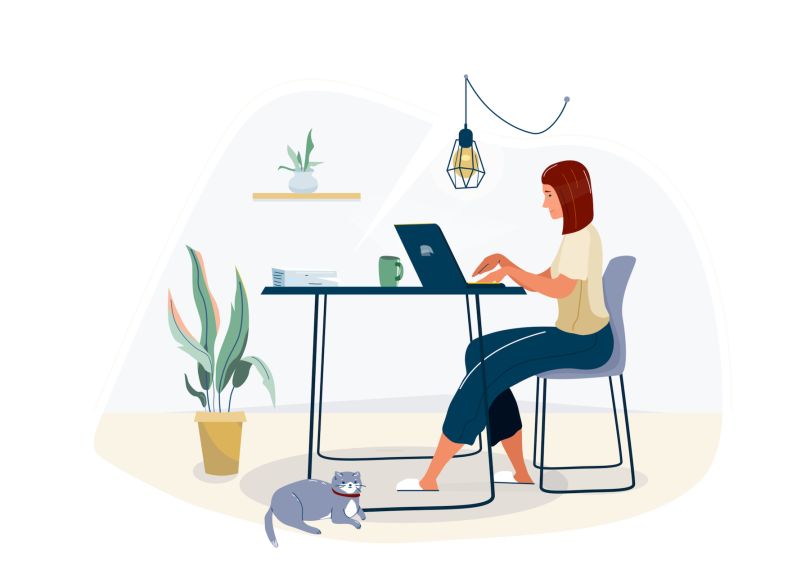On an average day, Kevin Boyle makes about 50 calls to small business owners as an account executive for the business management app provider vcita. Some are cold calls, others consultations, then there’s the product demos and, if all goes well, the opportunity to close a deal.
At the company’s Bellevue office, it doesn’t take him much to find his groove, what with a standing desk equipped with two monitors, meeting rooms at his disposal and coworkers nearby. But now that he’s making sales from home, where his bed beckons just a few feet from his desk and two roommates offer instant distraction, it’s been a little trickier to get in the sales mindset.
“I just felt like I had my head under water. I didn’t know what I wanted to do, which was confusing for me.”
It’s a challenge salespeople across the country are getting used to as companies continue to observe social distancing to limit the spread of COVID-19. While plenty of sales teams find success working remotely, not everyone’s home is equipped for work.
Some have to work back-to-back with their partners in tight quarters. One of my colleagues works at the kitchen bar with the microwave above her head, while her partner works on a folding table across the room. For them, work is a constant ballet of moving workstations to avoid the swinging microwave door, coordinating call schedules and trying not to appear on each other’s calls.
“Our apartment is nice for both of us, but we valued location versus space,” she told me. “We never envisioned working here.”
Whether you have a dedicated office or coexist with roommates in tight quarters, setting up an effective remote sales station is as much about creating the optimal physical space as it is mental. Here are some tips from salespeople at vcita, Austin-based automated push messaging service Pushnami and Seattle-based project management platform LiquidPlanner about how they’re navigating their work-from-home experience.
Tips For Making Sales From Home
- Set a plan for the day and stick to it. It can be difficult to separate work and home when your desk is feet from your bed. Creating a plan makes the work-from-home setup feel more like an office.
- Create a space that is dedicated for work. Boyle cleared off his desk in his bedroom and mounted a monitor to better simulate his work environment and stay focused.
- Dedicate time to check in with the team or strategize on video meetings. While it won’t replace the conference room strategy sessions in quality, Smith runs Zoom meetings and calls on top performers to help share strategies and facilitate those exchanges.
- It’s OK to be transparent and lean in to the at-home awkwardness on calls. Since everyone is going through shelter-in-place together, Lohman has found mentioning that her dog might bark can be a great conversation starter.

Set a schedule and stick to it
The first week was the toughest for Boyle.
Without the natural cadences of the office to rely on, he would wake up later than usual and feel listless between calls. When he wasn’t on the phone, he would pop his head into the living room to check on his roommates. He completed his work, but it felt impossible to keep up.
“I just felt like I had my head under water,” Boyle said. “I didn’t know what I wanted to do, which was confusing for me.”
It wasn’t until he re-established his morning routine, put on a button-down shirt and set an hourly to-do list that his desk began to feel like a workspace. Even though his bed was a few feet away and his roommate would be watching The Office in the living room, he could focus on his tasks.
“It’s like giving myself some parameters around what I’m allowed to do in a day,” Boyle said. “Because I’m at home it’s hard to have that work mindset, so I had to block off that time.”
LiquidPlanner Director of Sales Gretchen Lohman found her work seeping late into the evening as she adjusted to a work-from-home schedule. Everywhere seemed like the office, and there were always sales calls to make, emails to prepare or training to plan.
“For me, creating that structure allows me to say, ‘Nope, I’m ending my day at five today and these are the things that I need to get done.’”
For her, it was critical to determine what work she needed to get done in a day and what time she wanted to close her laptop. Establishing that schedule created a boundary between her workplace and her home life.
“It’s so easy to, after dinner, get back on the computer and continue working,” Lohman said. “For me, creating that structure allows me to say, ‘Nope, I’m ending my day at five today and these are the things that I need to get done.’”
That said, don’t forget about scheduling breaks in the day. Pushnami Sales Development Representative Manager Travis Smith encourages his team to take an hour lunch and plan for breaks as they need. Working from home, it’s important to know when to step away from the desk.
Related: The Best Remote Sales Jobs in Tech

Establishing a dedicated workspace
In vcita’s office, Boyle enjoyed working at a standing desk and having the freedom to move around while on a call. He also had a couple monitors to keep track of the 50 tabs he’d have open for prospecting and research.
During that first week at home, he struggled to navigate his tabs and complete work on his 14-inch laptop screen, while his desk contained the clutter of bills and other unrelated papers that could serve as distractions.
While some aspects of the office are impossible to recreate, like the desk or walking space, Boyle said multiple monitors and a clean desk are a must. After clearing off his desk, he dusted off a monitor in his closet and wall mounted it, which has helped him work more efficiently. He also has an Amazon Alexa play white noise to block sounds coming from his roommate’s TV.
“It’s really just a matter of knowing that this is my workspace,” Boyle said. “All that stuff on my desk is in a different place now so that it’s not my focus.”
Multiple monitors and quiet work space were also a must for Smith, who transformed his game room into his new office. His desk is equipped with three monitors, and the room has a dart board and an indoor hoop for breaks.
“It’s really just a matter of knowing that this is my workspace.”
The setup gives him a quiet place to make calls and juggle the other management tasks on his list.
“I just locked myself in this room with my dog, no TVs or anything like that,” Smith said.
Lohman sets up shop at her partner's apartment, where there’s a spare room that she uses as an office. During the workday, she keeps the door shut to focus on her calls.
Communication tools are important
While Smith is fortunate to have a workspace to bunker down in for the day, he misses the impromptu conversations he’d have in the office.
It’s also been tough to recreate the communication his team enjoyed. His team would also often gather in a conference room for strategy sessions. Sales is as much about those internal preparations and communication as it is outbound conversations.
“We get a lot done in the conference room,” Smith said. “It’s a little bit tougher with Zoom meetings.”
In an effort to stay connected, Smith has leaned on daily virtual stand-ups and twice-a-week team meetings on Zoom. On a video meeting, he’ll encourage people with the highest sales numbers that week to share any tips or strategies that they’ve had success with.
Meanwhile, the “SDR Squad” Slack channel has become the place where employees will virtually check in with each other in the morning and share how they’re doing.

Lean into the awkwardness
Before Lohman starts a call, she’ll often tell customers that they might hear a dog barking during the course of their conversation. While she works in an office, it’s impossible to avoid the bits of personal life that bleeds into the business.
But that’s not always a bad thing.
Since everyone is in the same situation, Lohman said pointing out that a dog is around or perhaps that a child might pop into the background can serve as a conversation starter. She’ll even ask about the prospect’s work environment and how long they’ve been working from home.
“It’s been a great conversation starter, and it builds that foundation that everybody’s in this together,” Lohman said. “It brings people together in a way.”
Boyle has found that bringing up the situation can also create opportunities to learn and grow. Sometimes he’ll exchange tips about working from home and gain some insight into how the coronavirus has affected others across the country.
Not everyone can have a perfect remote work environment. Acknowledging that can often create a connection on a call — just make sure your dirty laundry is put away, Lohman said.
“I just make sure my background isn’t dirty and there’s maybe a picture back there,” Lohman said. “It’s kind of fun to see everyone’s houses.”




